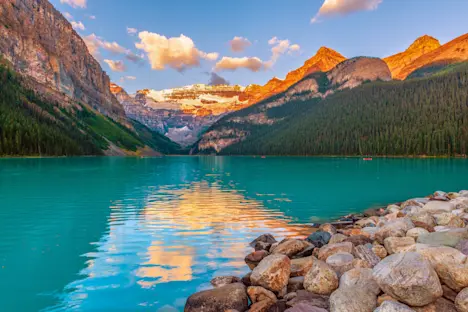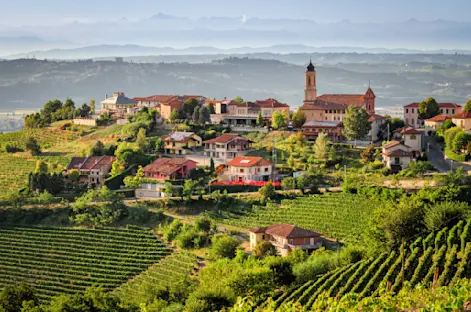
Know Before You Go: Alaska Adventures


When is the Best Time to Visit Alaska?
The best time to go on a wildlife adventure in Alaska is May through September, when long daylight hours and warmer weather create ideal conditions for viewing animals in their natural habitats. June and July are prime for spotting bears feeding on salmon, whales breaching in coastal waters and moose grazing in green valleys. May and early June offer excellent birdwatching and quieter trails as spring arrives, while late August to early September is ideal for fall colors, northern lights and wildlife preparing for winter. Natural Habitat Adventures offers expert-led Alaska trips that align with wildlife activity, giving travelers the best chance to encounter brown bears, humpback whales, orcas, bald eagles and other iconic species.
When is the best time to visit Alaska for wildlife?
Summer and early fall are the best times for wildlife viewing. From June to August, long daylight hours—averaging 18 to 22 hours in many parts of the state—mean more time to explore and spot wildlife. Bears, whales and other species are especially active during this season, and wildflowers abound. In September, the tundra ignites in shades of gold, crimson and rust as autumn settles in. Caribou begin their migration across the open landscape, and the northern lights make their return.
Highlights by Season:
Summer (June–Aug): Bears, whales, nesting puffins, wildflowers
Fall (Sept): Bears, caribou migration, northern lights, autumn colors
What is the weather like in Alaska in the summer?
Alaska’s summer weather can vary dramatically depending on the region. Expect mild temperatures ranging from the mid-50s to low 70s°F, with long daylight hours and frequent sunshine inland. Along the coast, conditions are typically cooler and wetter, especially in the southeast and along the Gulf of Alaska.
Interior: 60–80°F, occasionally reaches 90°F
Coast: 50–65°F, often rainy
Frequently Asked Questions
When is the best time to visit Alaska for wildlife?
The best time to visit Alaska for wildlife is the summer, from June to August, when animal activity is at its peak. During these months, you can spot brown bears fishing for salmon, whales feeding along the coast and puffins nesting on rocky cliffs.
Warm temperatures and extended daylight hours make summer ideal for wildlife viewing across Alaska’s diverse habitats—from coastal fjords to inland tundra. Visitors often enjoy close-up encounters from boats, viewing platforms and guided trails, with chances to witness feeding, nesting and migratory behaviors.
Top wildlife to spot in summer:
Brown bears catching salmon
Humpback whales bubble-net feeding
Puffins and seabird colonies on cliffs
Moose and caribou in river valleys
How many days do I need for an Alaska wildlife tour?
Plan for at least 7 days to experience Alaska’s top wildlife regions. Longer trips allow time to reach remote bear camps, explore multiple parks or add Arctic adventures.
Because of Alaska’s vast size and limited roads, travel takes time. A week gives you Denali and the Kenai Peninsula. For immersive bear viewing or off-the-grid wilderness, 10–12 days is ideal.
Sample trip lengths for Alaska wildlife:
7 days: Denali and Kenai Peninsula highlights
7–8 days: Fly-in bear viewing in Katmai or Lake Clark
10–12 days: National park combo or Arctic extensions
14+ days: Deeper wilderness immersion across regions
When can I see bears in Alaska?
Bears are most active from June through early September. Brown and grizzly bears gather along salmon streams in mid to late summer, creating excellent viewing opportunities. In May, you can often see bears emerging from hibernation.
What time of year is best for whale watching in Alaska?
The best time for whale watching in Alaska is May through September, with June and July offering the highest chance of sightings. Humpback whales, orcas and gray whales are common in coastal waters during this period.
When can I see the northern lights in Alaska?
The northern lights are visible from late August through April, when skies are dark enough. The best viewing conditions are typically in March and September during the equinox periods.
What is the warmest time of year in Alaska?
July is typically the warmest month in Alaska. Daytime highs often reach the 60s and 70s Fahrenheit, with long daylight hours and minimal nighttime cooling.
When is peak tourist season in Alaska?
Peak tourist season runs from mid-June through mid-August. This is when weather is warmest, wildlife viewing is at its best and most lodges, tours and parks are fully open.
When is the quietest time to visit Alaska?
May and September are considered shoulder seasons in Alaska. Visitor numbers are lower, but the weather is still pleasant and wildlife activity remains strong, especially for bears and moose in September.
What is the best time to visit Alaska for photography?
June through early September offers dramatic light, wildlife activity and clear conditions. Photographers favor late August and September for golden fall colors and a higher chance of northern lights.
What is the weather like in Alaska during the summer?
Summer weather in Alaska is generally mild, with daytime temperatures in the 50s to 70s Fahrenheit. Coastal areas tend to be cooler and breezier, while interior regions are warmer and drier.
How cold is Alaska in May and September?
In May and September, daytime temperatures usually range from the 40s to 60s Fahrenheit. Mornings and evenings can be chilly, especially in northern or coastal regions.
How many hours of daylight does Alaska have in June and July?
Alaska experiences 18 to 24 hours of daylight in June and July, depending on the location. In Fairbanks, the sun barely sets around the summer solstice, while Anchorage sees about 19 hours of daylight.
Does it snow in Alaska in summer?
Snow is rare at lower elevations during summer, but it can still occur in the mountains. High-elevation glaciers and peaks often remain snow-covered year-round.
Is it rainy in Alaska during the summer?
Rain is common in coastal areas during summer, especially in Southeast Alaska. Light rain or drizzle is typical, but it rarely disrupts travel. Interior regions tend to be drier and sunnier.
Alaska Tours
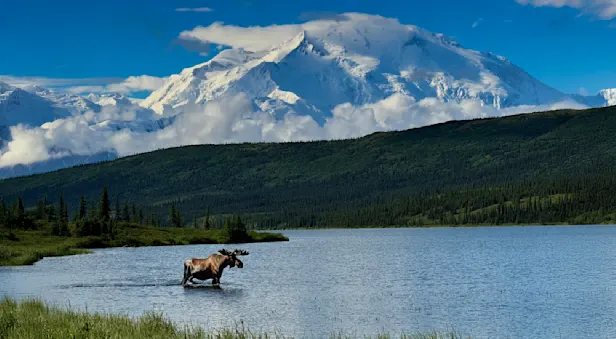
Ultimate Alaska Wildlife Safari
See more of wild Alaska on this wide-ranging, small-group adventure including Alaskan brown bears, a fly-in backcountry lodge in Denali National Park, marine life of Kenai Fjords, and the scenic Alaska Railroad to Seward.

Nat Hab's Alaska Bear Camp
A secluded immersion with brown bears in the wilderness of Lake Clark National Park—enjoy total privacy and comfort at our deluxe fly-in wilderness camp accessed via chartered bush plane from Homer.
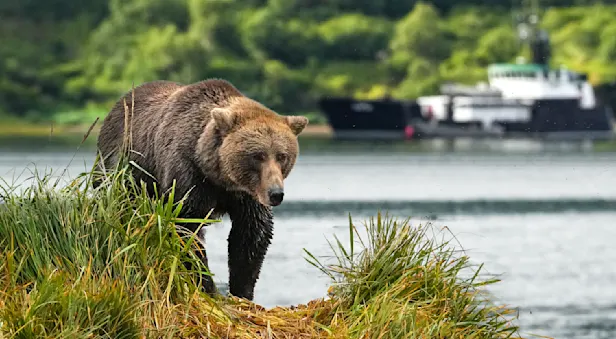
Alaska's Grizzly Ship: Kodiak to Katmai
An exclusive small-ship adventure to view giant brown bears—the world's largest "coastal grizzlies"—up close! Walk the shores as bears dig for clams, forage for sedges and pursue salmon in season in tidal streams.
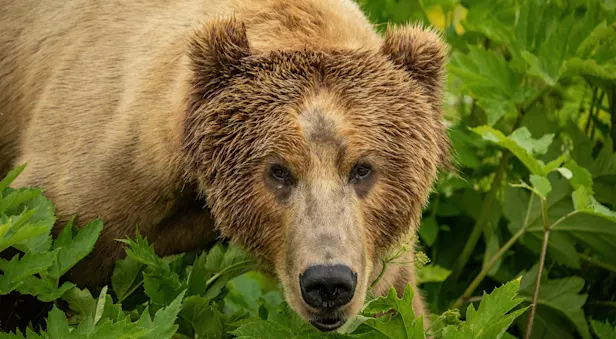
Ultimate Alaska Photo Expedition
A truly epic photography adventure! Alongside expert guides, get aerial shots of Denali from a helicopter; capture brown bear portraits at close range, and shoot glaciers, whales, puffins and more in Kenai Fjords.
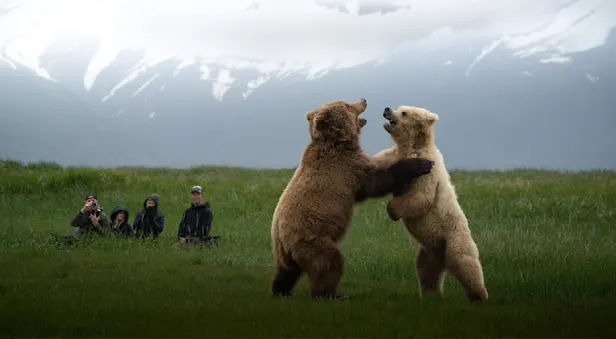
Grizzly Ship Photo Expedition: Kodiak to Katmai
Based aboard our private small ship, just eight guests photograph brown bears in the roadless Katmai wilderness, going ashore with an expert bear naturalist and photography pro who knows these animals intimately.
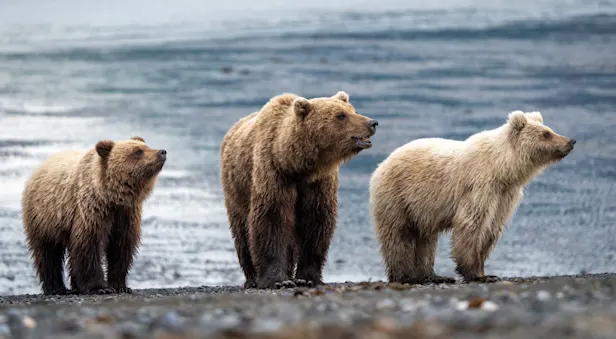
Alaska Bear Camp Photo Expedition
A secluded immersion with brown bears in the wilderness of Lake Clark National Park. Enjoy total privacy and comfort at our deluxe fly-in wilderness camp accessed via chartered bush plane from Homer.
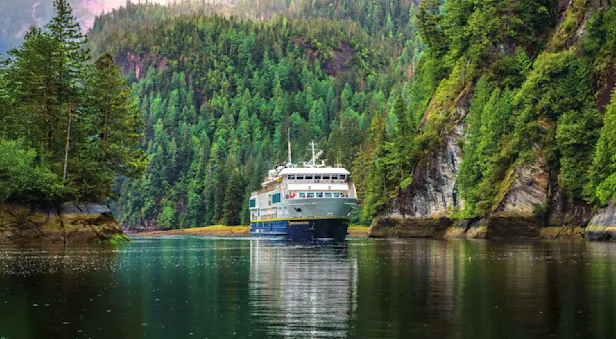
Alaska’s Inside Passage
A small-ship voyage through the narrow channels and fjords of Southeast Alaska's storied Inside Passage—meet wildlife up close in the company of top naturalists.






